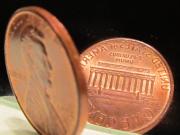Personally, I can not say thank you enough. I've been having soooo much trouble with doubles. This clearly explained AND shows the difference. Thank you for all the hard work of presenting this.
Cindy
Welcome guest, is this your first visit? Click the "Create Account" button now to join.
Results 21 to 30 of 40
Thread: Machine Doubling (MD)
-
08-06-2010 #21
-
08-06-2010 #22
Learning something new everyday is very important, and Jason has gone above and beyond as a great teacher.
Thank You Jason!
Jean
-
08-06-2010 #23DarylscoinsGuest
this is what we all need to understand more of the the types of doubling there really are,,, (MD) Next is the types of hub doubling.. this was very informative and detail pics OUTSTANDING!
-
08-10-2010 #24
r958D Cent
Another quick example of MD happens to have occurred on this 1958D that has a curious Die Chip on the 1 of the date. LCR member Colleen Davis (Shameless) sent me two examples showing the progression of the Die Chip ( A and B below) and how on the later example the Die Chip has Machine Doubling along with parts of Lincoln's portrait.
Oddly, a coin from the same die, on page 342 of The Error Coin Encyclopedia 4th edition (Margolis & Weinberg 2004); they state, "It is usually called the 'r958D' cent" as the r looks like a typed lower case r.

Last edited by jcuve; 08-10-2010 at 11:01 AM.
Jason Cuvelier
MadDieClashes.com - ErrorVariety.com
TrailDies.com - Error-ref.com - Port.Cuvelier.org
CONECA
(images © Jason Cuvelier 2008-18)___________________
-
01-26-2011 #25JimGuest
Wow! Now this was a killer tutorial and so well explained. I have read allot of books and you made this plain and simple. Huge Kudo's and a big thank you Jason.
Jim
-
03-20-2011 #26
A recent example sent to me by Eric (eaxtellcoin) is a 1966 with somewhat strong MD on the reverse that mimics a partial Class IV (Off-set) spread. The closeup of "S of" shows (white arrows) the absence of notching, and (red arrows) the way the apparent doubling cuts into the size and shape of the normal devices (letters).

Jason Cuvelier
MadDieClashes.com - ErrorVariety.com
TrailDies.com - Error-ref.com - Port.Cuvelier.org
CONECA
(images © Jason Cuvelier 2008-18)___________________
-
05-18-2011 #27
Seriously, these are the best pics and tutorial. What helps is the clarity of the color. wish I could take pics like that. Thank you.
-
07-30-2011 #28phjr1956Guest
Your dedication and knowledge are a real asset to all of us "uneducated"....Thank you!
-
12-05-2011 #29
Very Educational indeed.Great Job on the Article,Sir! God Bless!
-
02-06-2012 #30EgCollectorGuest
First i would like to thank you very much for this great lesson..... i finally can differentiate between both or at least i think i can ;)
I have a question regarding the cause of the doubling ..... for the MD i understand the cause but for the DD, how can a lost part of the die add the same shape and size of the date ? Hope you pardon my ignorance but i thought that DD would be a result of hitting the coin twice... if you could explain it more to me, i would appreciate it very much.
Thanks







 Reply With Quote
Reply With Quote



Bookmarks